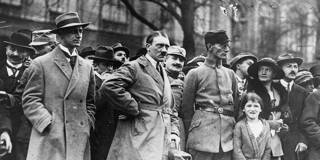A century after Adolf Hitler's first attempt to seize power in Germany by force, it is worth remembering the economic and political conditions that gave the Nazis momentum in the first place. In an era of recrudescent nationalism and chauvinism, such historical lessons have gained new urgency.
DUBLIN – This month marks an instructive centenary. On the morning of November 9, 1923, a 34-year-old Adolf Hitler led a column of 2,000 armed men through central Munich. The goal was to seize power by force in the Bavarian capital before marching on to Berlin. There, they would destroy the Weimar Republic – the democratic political system that had been established in Germany during the winter of 1918-19 – and replace it with an authoritarian regime committed to violence.
Marching alongside Hitler was a 50-year-old Bavarian regional court judge, Baron Theodor von der Pfordten, who carried a legal document that would have become the basis for the constitution of the new state. It included provisions to justify the mass execution of the Nazis’ political opponents, as well as especially drastic measures targeting Germany’s Jews, who accounted for around 1% of the population. Jewish civil servants were to be immediately dismissed and any non-Jewish German who tried to help them was to be punished with death.
The march was led by men carrying Swastika flags and included at least one truck with a machine gun mounted on its back. Standing at the front was Hitler, who wore civilian clothing, whereas everyone else had donned military or paramilitary uniforms.

DUBLIN – This month marks an instructive centenary. On the morning of November 9, 1923, a 34-year-old Adolf Hitler led a column of 2,000 armed men through central Munich. The goal was to seize power by force in the Bavarian capital before marching on to Berlin. There, they would destroy the Weimar Republic – the democratic political system that had been established in Germany during the winter of 1918-19 – and replace it with an authoritarian regime committed to violence.
Marching alongside Hitler was a 50-year-old Bavarian regional court judge, Baron Theodor von der Pfordten, who carried a legal document that would have become the basis for the constitution of the new state. It included provisions to justify the mass execution of the Nazis’ political opponents, as well as especially drastic measures targeting Germany’s Jews, who accounted for around 1% of the population. Jewish civil servants were to be immediately dismissed and any non-Jewish German who tried to help them was to be punished with death.
The march was led by men carrying Swastika flags and included at least one truck with a machine gun mounted on its back. Standing at the front was Hitler, who wore civilian clothing, whereas everyone else had donned military or paramilitary uniforms.